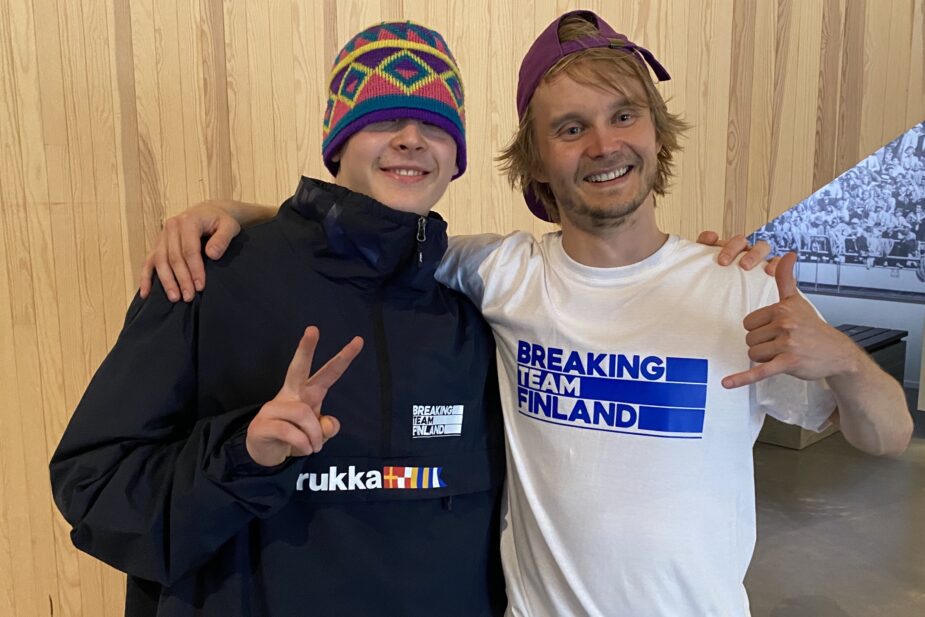Text: Emma Vainio
Competition and battles are an essential part of breakdancing culture. In the summer of 2024, the acrobatic dance style will make its debut on the Olympic stage in Paris. Both the Olympic Committee and breakdancers believe that this new discipline will attract new audiences to the Games.
Who would have believed a few decades ago that breakdancing would become an Olympic sport? It has come a long way from small dance sessions held in the basements of the Bronx.
Jussi ‘Focus’ Sirviö, the head coach of Finland’s breakdance national team, describes how dance culture originated in New York in the 1970s. “In 1973, DJ Kool Herc, who lived in the Bronx, decided to throw a party in the basement of his apartment building. The idea was to collect entrance fees to buy nice clothes for his sister for school in the fall,” Sirviö explains. “Everything started from that moment.”
The head coach himself started breakdancing at the age of 11 in Muurame, a small town in central Finland, in 1995. “I was at a disco where a circle was formed, and my friends started spinning on their backs and doing worms. I thought it was so insanely cool that I had to try it myself!”
Since then, Sirviö, who has been named an icon of Finnish street dance, has won numerous international breakdancing competitions, taught in hundreds of workshops around the world, and served as a judge in several of the world’s largest street dance competitions.
70 percent originality, 30 percent technique
Competition has been a significant part of breakdancing culture for a long time, with breakdance competitions being held since the 1980s. In 2018, breakdancing was included as a test sport in the Youth Olympics in Argentina. Now, there is just a year left until the Paris Olympics, and Finland’s national team of six men and four women is already fully preparing for the games.
Oliver ‘Ofi’ Finne and Elias ‘Elmonaattori’ Niskanen showcased their skills at the press conference of Finland’s breakdance national team at the Helsinki Olympic Stadium in a 1 vs. 1 demonstration battle. Finne smoothly absorbed the rhythm into his movements, while Niskanen took control of the floor with quick spins. What is the perfect balance between technical prowess and personal style in breakdancing?
“You need 70 percent originality and 30 percent technique,” Elias Niskanen assesses.
“There must be a solid foundation of fundamentals, on top of which you can build your own style. In essence, the more unique a breakdancer has on top of that foundation, the better,” adds Oliver Finne.
Playfulness makes breakdancing fun
Head coach Jussi Sirviö agrees. “Personal style and creativity play an extremely important role. This is also taken into account as an important aspect of judging. It’s not necessarily about having your ankle in a certain position, but rather encouraging breakdancers to express qualitative elements,” Sirviö explains.

“Of course, the discipline is highly technical and even challenging, but the playfulness, personal style and expression make breakdancing fun. I don’t think anyone who looks exactly like someone else will win Olympic medals,” the head coach concludes.
Breakdancing requires a strong mastery of one’s own style, as well as strength, endurance, and explosiveness. Elias Niskanen trains eight times a week. “Roughly five breakdancing sessions a week, lasting from one and a half to two hours each. Additionally, I have three weekly physical training sessions.”
“I have one rest day a week, so six training days,” says Finne. “Breakdancing sessions are usually about three hours long, and sometimes I train twice a day.”
How is a cultural phenomenon transformed into a competitive sport?
Jussi Sirviö states that intense competition has significantly changed the very essence of breakdancing. “If the art form originated in small club spaces and basements among young people, it’s a whole different story when it’s performed on an Olympic stage with three and a half billion people watching.”
On the other hand, breakdancing has long had a certain internal division. “Some compete on big stages, while others focus on dancing in clubs and parties. It is a richness that the art form offers different things to different people. There is no single format that one must fit into.”
There is no longer a divide between sports and culture; quite the opposite
Sirviö sees that sports are currently undergoing a transformation. “There is no longer such a strong divide between sports and culture; on the contrary,” he ponders. “Even the Olympic Committee has discussed the need to incorporate new culture into the Olympics, which is a significant revolution.”

Breakdancing and skateboarding attract new audiences
When Elias ‘Elmonaattori’ Niskanen started breakdancing, he could never have imagined that the art form would one day be at the Olympics. And it wasn’t even the goal.
“Becoming an Olympic sport opens up many opportunities for us. Nowadays, it feels much more acceptable to dedicate my time to this. In the past, people might have said, ‘What are you still fooling around there?’ Nowadays, having the status of a professional athlete improves outsiders’ perception of us.”
“Olympics also bring sponsorship money to breakdancing,” adds Oliver ‘Ofi’ Finne.
“But all in all, the Olympics benefit more from breakdancing than breakdancing benefits from the Olympics. We have discussed within the national team that the Olympics may no longer be as interesting for the younger audience, and the viewer numbers are declining. Breakdancing, skateboarding, and other new sports that are included bring new, younger spectators,” Finne concludes.
The Finnish breakdance national A team includes Anniina ‘AT’ Tikka, Tanja ‘Kid-T’ Kuurola, Ramona Panula, Johannes ‘Hatsolo’ Hattunen, Elias ‘Elmonaattori’ Niskanen, and Kimmo ‘Haiku’ Korpela. The national B team consists of Kristiina ‘Stinkki’ Mikhel, Pontus ‘P-Tech’ Linder, Hugo ‘Sparks’ Sandberg, and Oliver ‘Ofi’ Finne.
